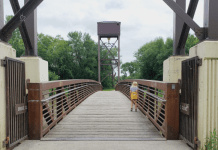
I first learned about the 1000 Hours Outside movement about three years ago, after my sister-in-law shared it with me on Instagram.
I quickly fell in love with the concept. Not only did it embody much of what’s important in our own family culture, but it felt like a valuable invitation and resource for families as we learn to navigate a world full of technology.
Born in the mid-late 80s, my husband and I are both a part of the generation that straddles the line — that last childhood devoid of tablets and smartphones, with an adulthood saturated in both.
Back then, TV entertainment was king. Those heavy, colorful iMacs were just starting to fill households and classrooms across America.
But for us, free play and time outside was still filling up much of our days.
A Technology Saturated World
Two kids and 30 years later, we seem to have made an 180 degree turn. Regardless of the time of day, seeing other kids out and about in green spaces seems to have become the exception, no longer the rule. Playtime outdoors has seemingly become little more than an afterthought, and even then, it has to compete with the powerful captivation with screens.
According to the CDC, American kids ages eight to 18 spend on average 2,737 hours on screens annually per child (7.5 hours per day, averaging 9 hours per day for certain age groups, and up to 12 hours per day with media multitasking factored in). These stats are based on a 2010 study that considers time spent on phones, computers, and in front of the TV for entertainment purposes.
This in comparison to the estimated average of four to seven minutes per day the average modern American child is getting in unstructured outdoor time, according to the website Outward Bound.
So Why Does This Matter?
The most obvious result of screen use is increased sedentariness, which can cause a multitude of health issues. But increasing studies are showing the effects are going deeper than that.
Poor sleep, attention difficulties, poorer long-term academic performance, increased behavioral issues, anxiety and depression, and deficits in cognitive, language, sensory, kinetic, and social-emotional development, are all cited as on the rise in kids, with strong correlations to screen use.
This isn’t to say that technology is some all-encompassing evil. To be sure, it can be an amazing tool if used in an intentional way. But more research is showing the heavy dependency is coming with a staggering cost, especially to kids.
Where Nature Comes In
Our bodies were not biologically designed for the artificial environment this high-tech world has steered us into.
Humans are, however, biologically built to interact with and respond to nature.
The examples are wide: our circadian rhythm, the way sunlight informs certain body functions throughout the day, the science of “grounding,” how our bare feet can gather information from the terrain, the amazing capabilities of our senses working in tandem, to name a few.
It’s no coincidence that the research on the positive benefit of time in nature is extensive. Not only is it good for our physical bodies, but it helps with our mental health and stress levels as well. For children specifically, unstructured play time in nature provides a nourishing environment for their physical, emotional, cognitive, and social development.
How the 1000 Hours Outside Challenge Can Help Bridge the Gap
1000 Hours Outside was founded by Michigan homeschooling mom of five, Ginny Yurich.
Ginny uncovered the gift of outdoor time for herself and her family when she was a self-described overwhelmed young mother of three little kids. Around the same time, she also came across those screen time statistics of modern children. Knowing firsthand the benefit of more time outdoors, she created the 1000 Hours Outside Challenge to help other families.
What Is It?
The premise of the challenge is simple: to match screen time with outside time by clocking and tracking 1000 hours outdoors within one calendar year. This averages a little more than 2.5 hours per day.
While this may sound like a lot, keep in mind some days might naturally accrue way more hours than others.
What “Counts” as Outdoor Time?
There are no hard and fast rules for the challenge.
Since the point is to immerse in nature, strive to keep devices out of sight or left home, as safety allows.
Aside from that, outdoor time can be as simple or adventurous as you want it to be. A walk around the neighborhood, playing in the sandbox, an evening spent around the bonfire — all count towards the goal.
The other beauty of this challenge is that it doesn’t need to cost anything. Backyards, city parks, a walk down a gravel road — you don’t need to get fancy.
And you don’t need an agenda for time outdoors. However, you may find you need a little help getting started or some ideas along the way. The 1000 Hours Outside website has a ton of resources.
Tools for Tracking
To log your time outdoors, the website offers free downloadable tracker sheets with some really cool designs to choose from. They’re a fun and visual way to keep kids involved in the goal!
Every design is made up of 1000 boxes. For every hour spent outside, kids can color in one “box” on their sheet. When the goal is met, the entire picture will be colored in!
Another way to track time is to purchase the 1000 Hours Outside app (and yes, it does seem a little ironic). Just click start on the timer when you head outside, and the app will track and record your hours for you. Just set it and forget it until you come back in.
Virtual milestone badges can be earned along the way on the app (10 hours, 50 hours, 100 hours, etc.) and there’s journal feature and a place to upload pictures to document your experience.
When to Start
While the fresh start of a new year is great, you can start at any time.
For our first challenge a few years ago, I purposefully started it in the fall. I wanted to create a better habit of getting outside consistently during our long winters (it worked).
You Can’t Fail
Okay, yes, technically you can fail to reach 1000 hours by the end of the year. But as you get through your hours, you’ll start to see outside time less about a goal and more about developing a good habit.
I’ll be honest — we never officially completed our first challenge with our toddler. We got about six months in before I started dropping the ball on recording our hours.
But by that point, it didn’t matter. The challenge had helped us stretch out of our comfort zones. We built up resiliency by going out in all kinds of weather (yes, even through winter). We were now getting outside daily without thinking twice about it.
And that, I think, is the whole point.
So even if you’re not an “outdoorsy” family, or you have really little kids, or you think your schedule couldn’t possibly hold one more thing — I highly encourage you to give it a go anyway. Make it your own, and just start.

















So good! We are working on our 1,000 Hours, too. Thanks for the encouragement, Caitlin!